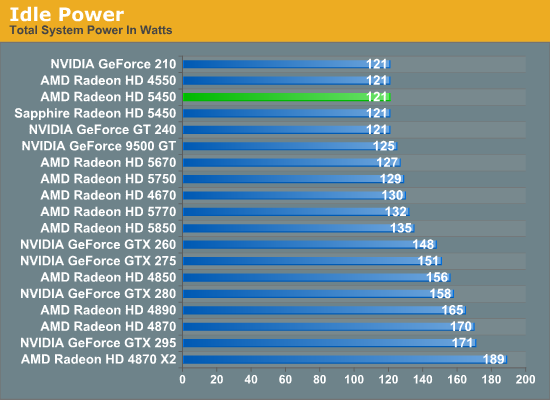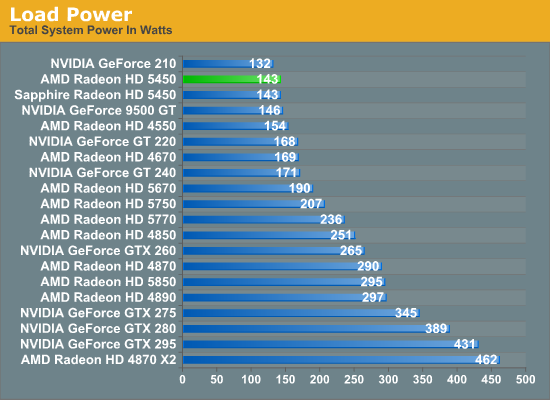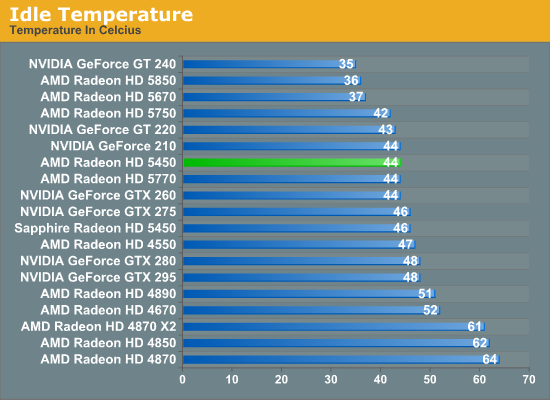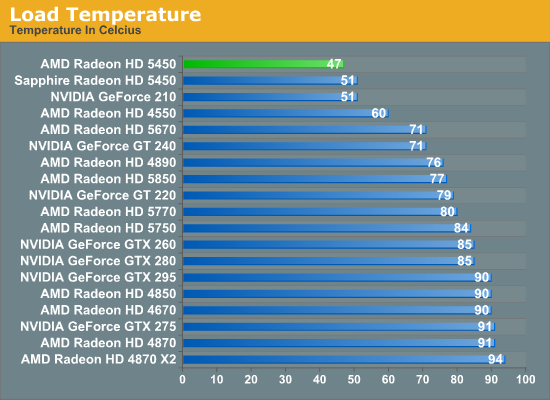AMD’s Radeon HD 5450: The Next Step In HTPC Video Cards
by Ryan Smith on February 4, 2010 12:00 AM EST- Posted in
- GPUs
Power & Temperatures
While entry-level video cards may not top the performance charts, their low transistor count and low power usage means that they do very well on our power and temperature charts. And by being passively cooled, they are winners by default for noise, as they don’t generate any noise to measure.


On paper these cards differ by around a few watts when it comes to idle power, but by the time you put them in our i7 test rig, those few watts melt away. The Radeon 5450, the Radeon 4550, and the GeForce 210 all idle at 121W on our test rig, tying with the GeForce GT 240 for the lowest idle power usage we’ve measured.
Under load this changes some. The 5450 offers the second-lowest load power usage that we’ve measured, coming in below things like the GT 220 and the 4550. It doesn’t quite best the GeForce 210 however, which we believe to be a combination of the 210’s smaller-yet GPU and differences to how NVIDIA and AMD go about throttling their cards when we’re running FurMark.
At any rate, the 5450 does particularly well against other AMD cards, not only beating the 4000-series, but coming in under the 5670 by a hefty 47W. The 5670 may be the better HTPC card from a deinterlacing standpoint right now, but you pay for it with power.


We should note that for our load temperature testing, we use a closed case with all of the fans active on our Thermaltake Spedo case. So the results here are from plenty of airflow being sent towards the first PCIe x16 slot. Since we’re looking at passive cards today, they’re much more affected by this than actively cooled cards are. In a case with little to no airflow, these passive cards would definitely get hotter.
For load temperatures, the 5450 is the coolest video card we have ever tested, taking the title by 4C over its nearest competitor, the GeForce 210. This is thanks in a large part to the use of a double-wide heatsink for better heat dissipation, and of course the low power consumption of the 5450 in the first place. This also gives us a chance to quantify the differences between the double-wide heatsink on the reference card and the single-wide heatsink on the Sapphire 5450; the smaller Sapphire heatsink is only 4C worse at 51C. The double-wide heatsink in this case looks to be overkill.
At idle things change some. Our coolest cards are the actively cooled cards, which have their own fans to keep them cool. The passively cooled cards on the other hand build up some additional heat, coming in at the mid-40s, similar to several of our mid-range cards.










77 Comments
View All Comments
Taft12 - Thursday, February 4, 2010 - link
Replying to my own post to say I reread the 5670 article and indeed the 5500 series is mentioned there and I am VERY sure this is what Ryan was referring to earlier when he said "wait a week"juampavalverde - Thursday, February 4, 2010 - link
I dont see the improvement over the past generation 4550. DX11 is useless in such slow cards (is almost useless for a 5670!). I expect this level of performance from a next gen IGP, not a discrete chip. AMD should have raised high the performance bar for this generation, releasing something like 5450 (120 sp), 5670 (640 sp, like 4770), 5770 (960 sp), and 80 sp for the IGP.Taft12 - Thursday, February 4, 2010 - link
The improvement is purely in power consumption. They can't improve performance of these lowest-end discrete cards or IGPs too much or they will eat into the value of the next step up (4670, 5670). You may "expect this level of performance" but you aren't gonna get it.Rick83 - Thursday, February 4, 2010 - link
I'd be rather interested in seeing a differentail analysis of power consumption of the two ATI cards (5450/5670) at rendering a h264 encoded 1080p movie with dts out via the card, as well as blu-ray with "HD".And a video benchmark, to show how much bitrate/fps the respective cards manage, before desync/framedrop/freeze.
Power during furmark (or gaming) is of course higher on the 5670, because it has five times as many shaders to feed - depending on how smart ATI's power management is, the two cards might not differ a lot, if used in an HTPC.
And frankly, the 50 dollars extra would be probably worth the extra rendering/decoding horsepower, especially in an HTPC, where you want buttery smooth performance, and not worry about bitrate.
Oh - any news on passive 5670's? If they can do 5750's, I'm sure there'll be a few 5670's someday?
Ryan Smith - Thursday, February 4, 2010 - link
This isn't something we tested since it really isn't an issue. The Cheese Slices test peaks at 35MBps MPEG-2, and I have an H.264 version that peaks at a similar bitrate.The 5450 has enough power for anything up to 1080p Blu-Ray.
Rick83 - Thursday, February 4, 2010 - link
Well, considering the extra shader load added by filters, apparently it may not be - or the proper algorithm for deinterlacing would have been available.And that also leaves the question of the power draw of a 5670 at 5450 levels of performance - I'm pretty sure that in an HTPC, unless you use it as a console replacement for gaming, there will ever be a situation where the gpu is fully loaded, hence power input should be lower than the full-tilt number you published.
dagamer34 - Thursday, February 4, 2010 - link
Most HTPCs are meant to be small, and there's no way you're going to be able to fit a 5700 series card into a low-profile space. I know they had 4650s last generation, but there aren't any 5650s yet. =/Redstorm - Thursday, February 4, 2010 - link
I just cant see how reviewers are claiming this card is the perfect HTPC video card. Not everyone uses Microsofts Media Centre. Lack of VDPAU support for Linux is a glaring hole in all ATI cards, If I were building a gameing PC today I would probably buy an ATI 5870, But if your building a low power HTPC you cant go past nVidia and VDPAU support. Take their ION platform will do 1080p in hardware on Linux for less than 30Watts this beats this ATI offering hands down when you add in Motherboard and CPU.Best HTPC card I think not...
CiNcH - Thursday, February 4, 2010 - link
XvBA is also said to be working, which also acts as a backend to VA-API, just like VDPAU. They are even examinig the legal situation and whether the UVD specs can be opened to be support within the OSS (xf86-video-ati) driver. Of course nothing that will be done by tomorrow.What I think would be worth mentioning, when it comes to HTPC comparing nVIDIA and ATi, is that UVD won't play H.264 higher than level 4.1. nVIDIA's PureVideo is capable of decoding up to level 5.1.
milli - Thursday, February 4, 2010 - link
The Evergreen series does apply angle independent anisotropic filtering. Also the fixed function interpolators have been removed and moved to the shaders.Considering the limited power of the HD 5450, this causes a bigger performance drop compared to the other Evergreen products.